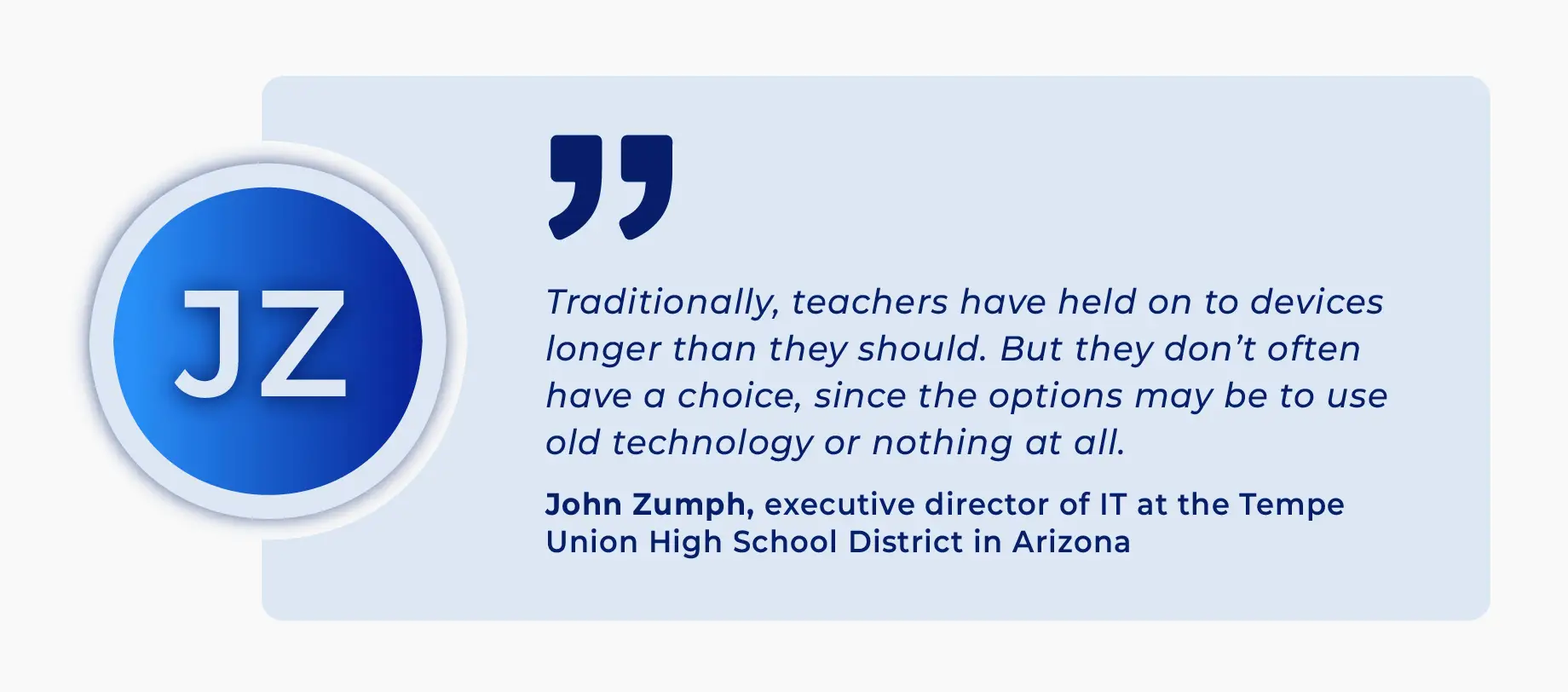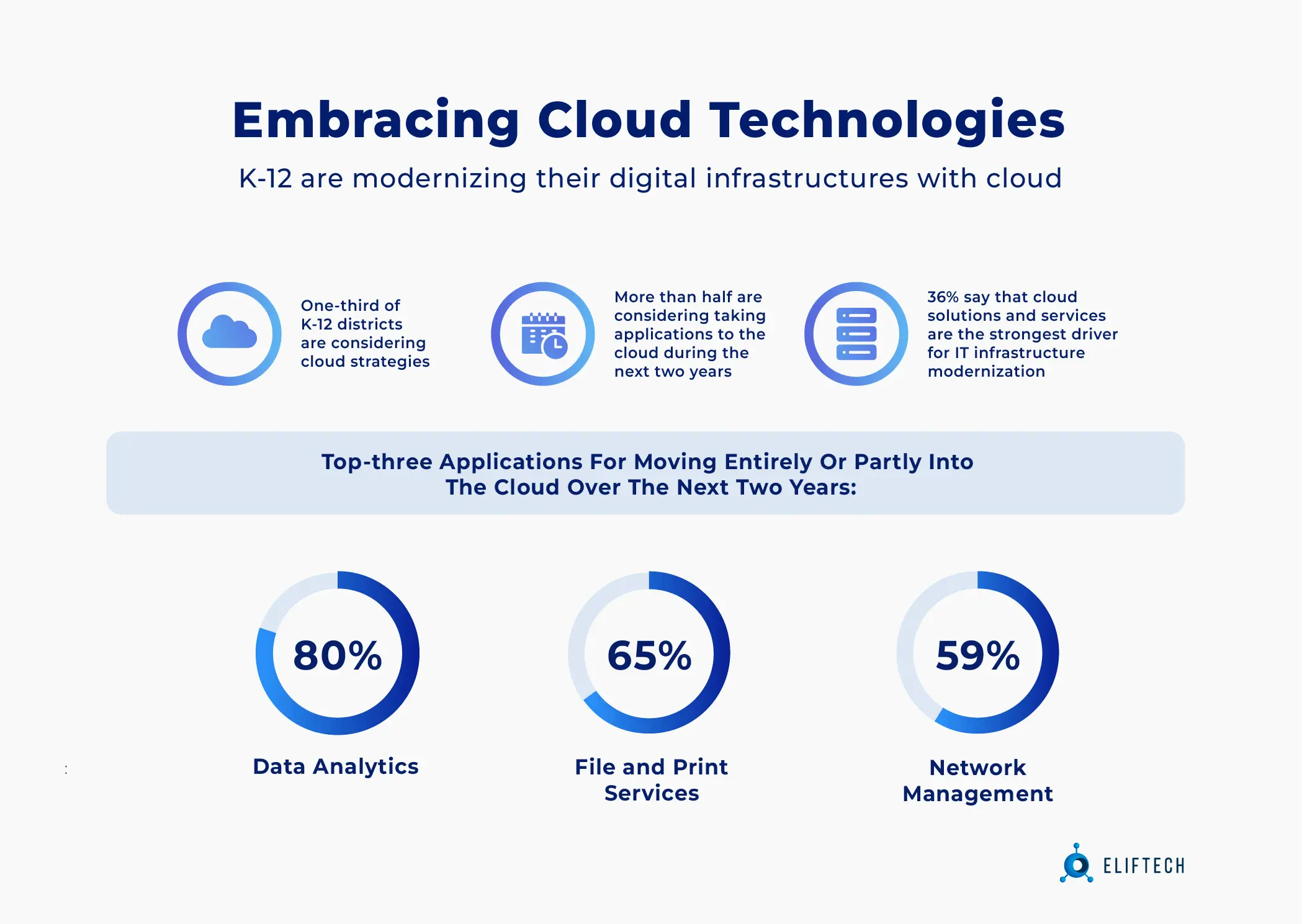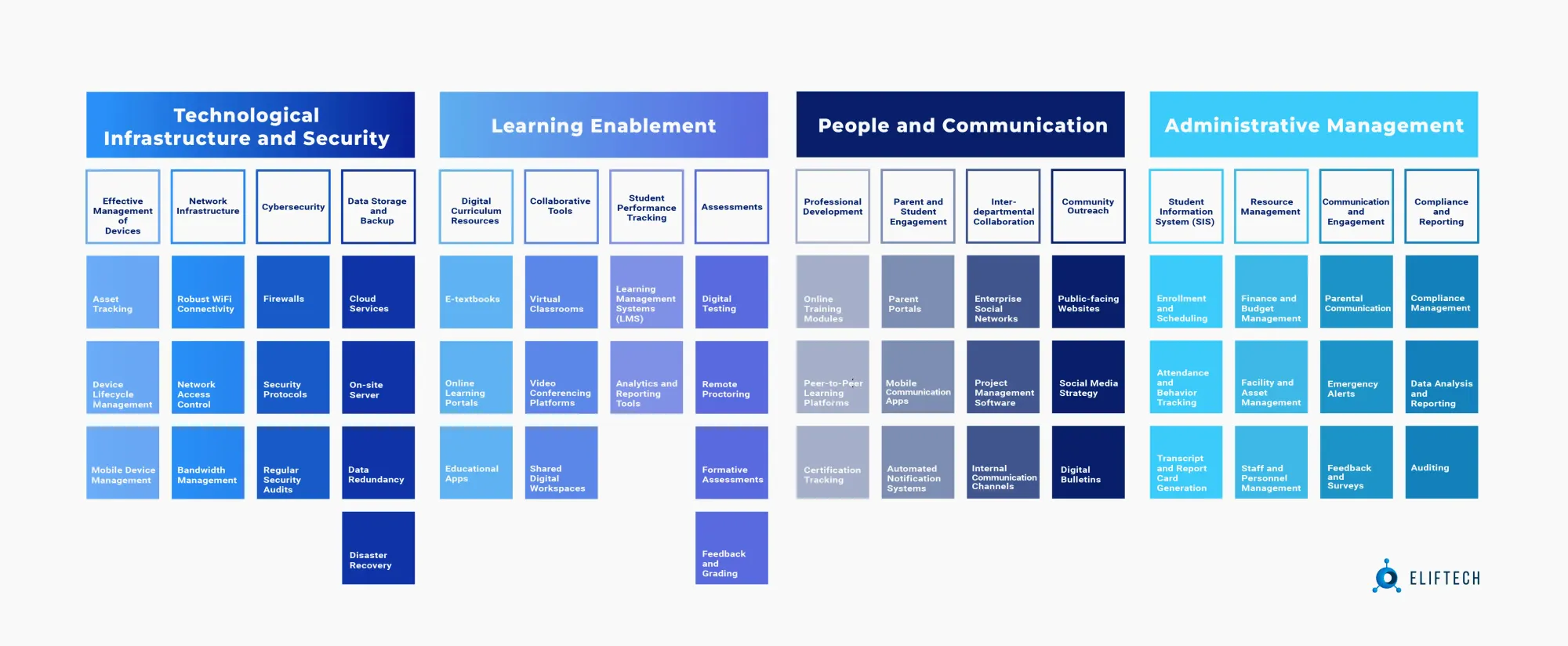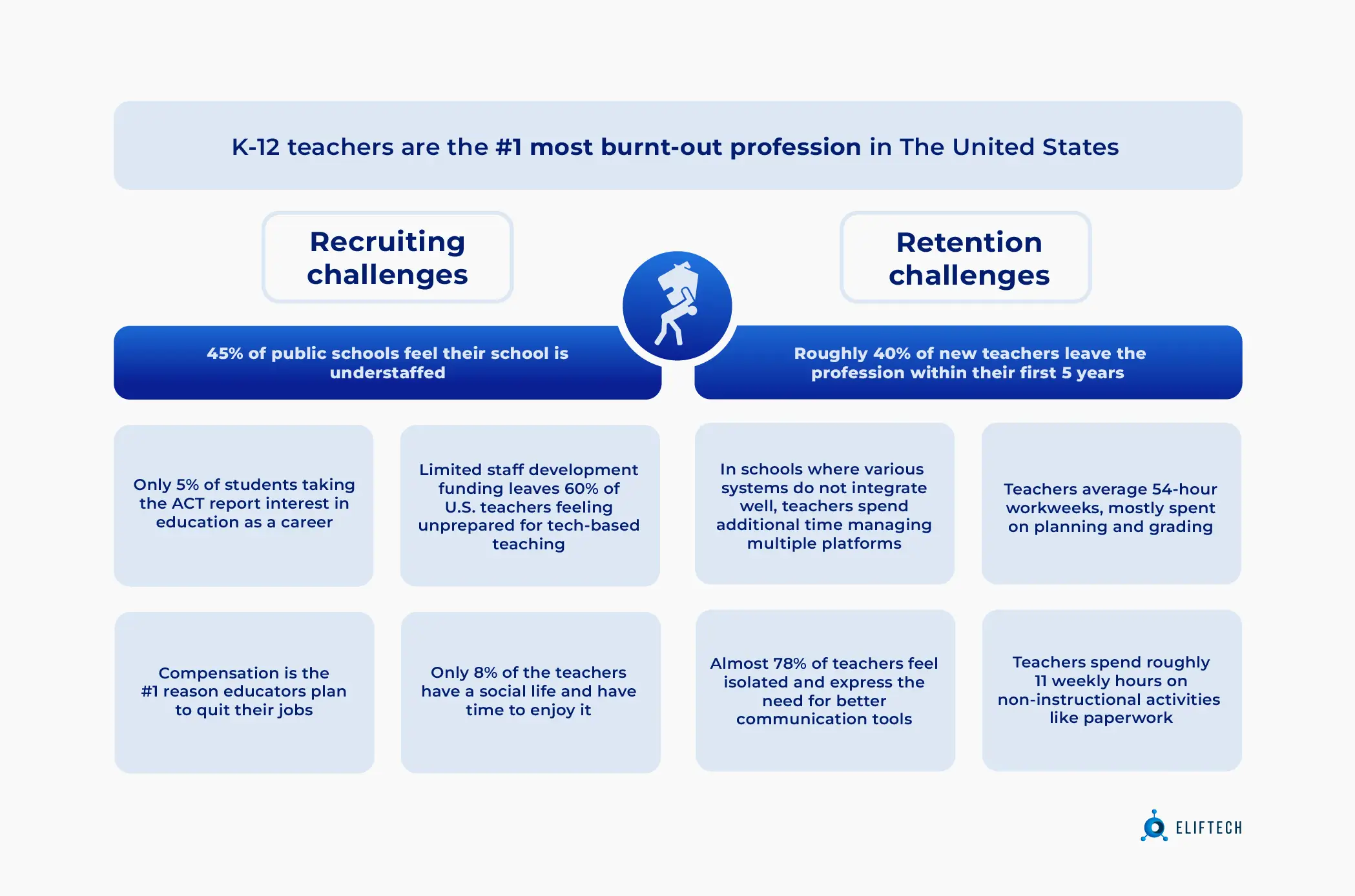EdTech
Digital Transformation in Education: Technology Modernization Roadmap for K-12

Between 2021 and 2026, the K-12 education market is predicted to grow at a rate of 31.6% with a key theme at its core: transformation. In K-12 education, this transformation has long been focused primarily on the classroom, but a new paradigm shift is underway: traditionally swamped with mounds of paperwork and labor-intensive tasks, now schools are looking for ways to improve their administrative operations as well.
This shift reflects a broader understanding that technology invites us to look beyond just the digitization of teaching practices, to recognize how technology is revolutionizing school management as a whole, forging a cohesive system where administrative tasks, resource coordination, and community engagement are seamlessly interconnected.
We’ve all heard of innovative systems like student information platforms, learning management tools, attendance trackers, and real-time performance analyzers, and the potential they hold. These systems, brimming with AI EdTech startups and big data technology, are reshaping administrative tasks and operations.
Yet, a critical question remains unanswered: how can educational institutions integrate these advanced technologies smoothly amidst the many tech barriers they face?
This article carefully analyzes the path towards a digital transformation in education. Leveraging relevant research and our internal expertise, it sets forth a concise yet robust framework for modernizing K-12 digital infrastructure.
K-12 school technology challenges to overcome with tech
As K-12 schools rapidly adopt digital tools to revolutionize both teaching and administrative tasks, they find themselves grappling with a host of new obstacles. Despite significant portions of the IT budget – up to 43% – being dedicated to integrating state-of-the-art technologies such as cloud computing and big data analytics, the path to modernization is far from smooth.
While the K-12 sector is under immense pressure to keep pace with modern technological standards and practices, it contends with significant roadblocks. Most notably, the shortage of qualified personnel to handle these technological transformations and deep-seated resistance to change due to longstanding traditional practices serve as primary hindrances. Although EdTech startups are already transforming the educational landscapes, the system still lacks strong connections between schools and businesses to connect the proposition with its final beneficiary.
These, of course, are only part of a larger landscape of digital transformation in education.
Outdated infrastructure
Embracing digital transformation in education, we can't ignore the giant elephant in the room – outdated infrastructure. These systems, initially designed to fulfill the needs of a more analog era, now struggle to provide the seamless interactivity and real-time data exchange that today's digital age demands.
For instance, an archaic student information system might imply manual updates and data entries – resulting in inaccuracies and causing delays in accessing real-time student information. Outdated communication systems in school may restrict real-time parent-teacher interaction, weakening the home-school connection crucial for student success.
In addition to aging infrastructure, the continued use of old and slow devices also presents a considerable hurdle to modernization efforts in education. These devices may not be compatible with the newer, more sophisticated software that's pivotal for a modern classroom experience. They often require frequent maintenance and patching to remain operational, diverting resources away from more progressive initiatives.

These aren't mere inconveniences; they directly impact educational outcomes and operational efficiency. Even worse here is that upgrading these systems isn't straightforward. The substantial costs and operational disruption, not to mention the necessary investment in staff development, present a triad of challenges.
System fragmentation
The limitation of system interoperability poses an additional challenge. With schools on average juggling 10 to 15 different systems for various tasks, maintaining a centralized view becomes an uphill task. Consider the instance of a school using separate databases for the library and student records. If these systems don't "talk" to each other, identifying a student who habitually keeps overdue books may become a time-consuming task, resulting in delays in resolving the issue and potential loss of resources.
To solve this problem, schools are increasingly investing in integrated systems, particularly cloud-based solutions which offer inherent advantages in terms of interoperability, scalability, and easy access across devices. In fact, based on the deployment mode, the cloud-based segment dominated the K-12 technology market with a major revenue share. In a recent survey, 70% of IT managers believe cloud-based tools will see the most significant growth in the next three years. Sound logical since coupled with comprehensive staff training for effectively handling the updated cloud-based infrastructure, these steps can pave the way for efficient information flow and optimized use of resources in educational institutions.

Budgetary consideration
Digital transformation in education also presents the classic conundrum of cost versus benefit. 40% of K-12 IT leaders cited budget constraints as their leading challenge in edtech implementation. School districts often operate on limited budgets, with significant portions allocated to personnel, infrastructure, and student programs. Investing in system modernization is a costly affair that demands a justified allocation of resources. Yet, the potential long-term benefits and savings: out of an estimated $13.2 billion spent on ed tech each year, proper implementation of modern systems could lead to at least $3 billion in savings for school districts. The ongoing challenge, however, is persuading all stakeholders – educators, administrators, and policymakers – of the long-term gains that come from upfront expenditures in technology.
Resistance and training
Another critical challenge is the implementation and change management involved in system modernization. Resistance to change is an expected human behavior. Teachers and administrators already burdened with their primary responsibilities may feel an added weight with the learning curve modern systems can introduce.
However, a well-planned approach to digital transformation in education with significant emphasis on effective training can help overcome this resistance. In fact, in recent surveys, education leaders from K-12 to higher education highlighted their top strategies for managing this transition. Approximately 43% of respondents are prioritizing staff training to ease the implementation of new tools, while 36% are focusing on identifying opportunities for performance and experience improvements.
These approaches underline the importance of not only bringing in the new systems but also sensitizing users to the benefits of these upgrades.
Cybersecurity concerns
Lastly, the question of data security looms large. Consortium for School Networking, the association that represents district ed-tech leaders, listed cybersecurity as their No. 1 concern. With massive data generation and transmission, schools hold a significant responsibility to protect sensitive student and staff information. However, the core issues impeding robust cybersecurity in educational environments are multifaceted. Financial limitations often mean that investing in state-of-the-art cybersecurity infrastructure is not always feasible. This lack of investment leaves schools with outdated security systems that are ill-equipped to ward off modern cyber threats.
Moreover, there is frequently a deficit in cybersecurity knowledge among school staff, which is necessary for operating and maintaining secure digital environments. This skill gap can lead to weak spots in a school's defense against cyber incidents. As a result, a pivotal part of modernizing schools isn't just about adopting new technology but also ensuring that the technology can be protected against ever-evolving cyber threats.
Tech modernization framework for K-12: What inside?
Digital transformation in education is not just about replacing paper with pixels – it's about transforming the entire educational ecosystem. It involves a comprehensive transformation of the entire educational ecosystem, reshaping and redefining the integration of technology across all aspects of a school's structure.
Each part of the school ecosystem – be it classroom instruction, administrative tasks, or school-community communication – can benefit immensely from tech modernization. Knowing exactly how and where technology can help leads to better and more complete use of modern tools in schools.

Technological infrastructure and security
The successful implementation and sustainability of tech modernization in the K-12 education sector rely heavily on the establishment of a robust technological infrastructure and a comprehensive security framework. These elements not only support the effective deployment of ed-tech solutions but also ensure the protection of sensitive data and the mitigation of potential risks associated with cyber threats.
In the context of technological infrastructure, there are the following aspects to consider:
- An efficient, scalable, and reliable network which is the backbone of any modern digital educational setup. This should ideally facilitate the fast and smooth transfer of information, allow for adaptability in case of increased demand, and maintain a consistent connection across various points in the educational system.
28% of K-12 school districts outsource their network maintenance.
- Effective management of devices – including computers, tablets, and interactive whiteboards – is crucial not only for accessing software and online platforms but also for ensuring the security and optimal performance of a school's technological infrastructure. Unmonitored, outdated hardware, such as switches and routers, can pose serious security risks and introduce bottlenecks that impair the overall functionality of the system.
- Appropriate solutions for data storage and backup, including cloud-based systems, need to be put in place. Regular data backups are crucial to prevent data loss in emergencies and ensure data integrity.
A vigorous security framework is also integral to any K-12 tech modernization:
- Implementation of robust cybersecurity measures such as firewalls, encryption tools, antivirus software, and intrusion detection systems is vital to protect against cyber threats.
- In the process, we shouldn't forget that regular security awareness training programs for staff and students are highly important to understand potential cybersecurity threats and adopt preventive measures.
- Lastly, a clear and comprehensive incident response plan is also fundamental to managing and mitigating potential security breaches. This encompasses detection, response, recovery, and post-incident analysis to prevent future occurrences.
Learning enablement
Educators today confront a pressing challenge: the lack of student engagement. To combat this issue, teachers are calling for enhanced professional development with a focus on incorporating technology. Its inclusion in classrooms can revolutionize pedagogy by offering interactive tools that boost student engagement, making learning dynamic and personalized. This approach can make complex subjects more approachable and fun, enhancing the overall learning experience.
Furthermore – considering that K-12 teachers are the #1 most burnt-out profession in The United States – automating administrative tasks can significantly lighten the teacher's burden. 44% of teachers in K-12 schools report often or always feeling burnout. Instead of spending hours on grading or attendance, they can rely on technology to handle these operations efficiently. This reduction in manual, repetitive tasks gives teachers more time to focus on the educational needs of their students and invest in their professional growth – key factors in mitigating feelings of burnout.

Moreover, technology streamlines school administration. Digital systems for scheduling, student records, and other operations reduce paperwork, enhance accuracy, and allow staff to focus on meaningful work.
In short, this transformation is akin to renovating an age-old structure with modern materials and architecture – resulting in an upgraded, efficient, and future-ready building. Similarly, tech-empowered learning enablement metamorphoses our educational process, making lessons more engaging, teaching more efficient, and learning more personalized.
- Digital curriculum management: By moving away from physical handouts and adopting a cloud-based system of content distribution, educational materials can be organized, updated, and shared instantly. For instance, a teacher could prepare an entire semester's worth of lectures, assignments, and supplementary resources and make them available to students online, facilitating seamless access and real-time updates to the study content.
- Assessments: The evolution of online assessments has reshaped the feedback loop in education. Instead of waiting days or weeks for graded assignments, students can receive immediate results and constructive feedback from automated evaluations. The automation in grading comes from sophisticated algorithms that can evaluate responses, even essays through Natural Language Processing, in real-time. This timely, dynamic process decreases administrative burdens and manual grading workload for teachers, freeing up their time for more focused instruction.
- Learning content: Digital platforms enhance accessibility for learners with different abilities by incorporating assistive tools, designing inclusive content, and enabling flexible learning times. They also facilitate wide-ranging collaboration among educators, paving the way for a diverse and rich learning experience for students. In addition, by leveraging data analytics, educators can gain insights into the effectiveness of the learning content, enabling continuous refinement of teaching strategies and materials based on student engagement and performance data.
People and communication
People and communication represent the human element in the K-12 tech modernization picture. This modernization can attract and foster tech-adept educators, leverage data for more effective teaching, smoothly incorporate new technologies, encourage stakeholder involvement in decision-making, and enhance parent-teacher communication. Ultimately, this can optimize our educational environment, making it more responsive to today's needs and tomorrow's innovations.
The critical areas covered in relation to people and processes are:
- Data management: With a surge in digital learning tools, schools now have access to massive amounts of data. Skilled data management is necessary to parse through this data, ensuring compliance with privacy regulations, usability for educational insights, and overall data security.
- Change management: As technology evolves, schools continually face changes in software, hardware, and practices. Change management processes are essential for smoothly implementing these evolutions while minimizing disruptions to learning and helping teachers, students, and parents adapt to them.
- Collaborative decision-making: Involving all stakeholders—teachers, students, administrators, and parents—in the decision-making process can promote buy-in and ensure that tech modernization caters to everyone's needs effectively.
- Parent communication: Strong parent-teacher communication channels enabled by technology foster partnership in student education. Modern tools and platforms provide parents with real-time insights into their child's progress and school updates, making them active participants in the educational process.
Administrative management
Leveraging technology to streamline administrative tasks can lead to increased efficiency and productivity while reducing costs and mitigating risks. It includes the optimization of daily administrative operations, strategic planning, resource allocation, and decision-making processes supported by data. It covers:
- Budget management: Modern financial tools allow for efficient budget planning and execution, enabling school administrators to allocate resources more effectively. They provide real-time insights into spending and warn about potential budget overruns. In addition, they streamline the process of reporting and annual budget submissions by presenting data in easy-to-read formats.
- Policy and regulatory compliance: Technology can assist in navigating policies and regulatory requirements relevant to education. Compliance tools can monitor new updates or changes to laws and policies, ensuring that schools are always up-to-date. They can also create reminders for necessary audits or compliance reports due to regulators.
- Staff management: Technology can help in various areas of staff management, such as recruiting, onboarding, professional development, performance evaluation, and much more. Digital HR platforms can standardize the process and improve the accuracy and effectiveness of HR functions. For instance, they can make it easier to manage staff scheduling, time-offs, contract renewals, etc.
- Student transportation management: Moving students to and from schools is a massive logistic challenge that technology can simplify. Modern routing software can develop optimal routes for buses, considering various factors like safety, travel time, and distance. They can also provide real-time updates to parents about bus locations and delays.
- Facility management: This can include the efficient management of a school's physical resources. Tech tools can help monitor usage and maintain records of facilities like laboratories, gyms, and libraries. They can also schedule maintenance, manage inventory, and predict future resource requirements using historical data.
6 steps to technology modernization in public schools (roadmap)
Mapping out all areas of potential technology modernization can indeed make the task seem substantial. And, in fact, it is, as the process demands astute planning and execution. Over 51% of school districts find this integration challenging, mainly due to the capacity constraints of in-house IT departments. In fact, only 30% of K–12 respondents reported being least well-positioned to modernize infrastructure, indicating prevalent challenges such as limited budget, staff resources, and lack of executive support.
This predicament underscores the dual barriers schools must surmount: bolstering their technological infrastructure and lack of resources and tech proficiency to do so.
Schools are navigating these issues strategically. For instance, instead of relying exclusively on in-house teams, they are forming partnerships with tech companies. These alliances offer access to specialized expertise and advanced solutions, supplementing and strengthening internal capabilities. Regardless of the model employed, a clear roadmap, reflecting the desired future state, lays the groundwork for successful implementation.
Evaluating current infrastructure
Evaluating the current infrastructure is a critical step in K-12 education's digital transformation. This involves a meticulous review of existing technologies, from hardware and existing systems to assessing their integration and communication capabilities. Say, for instance, integrating a cloud-based learning platform into the existing Information System might be on the agenda. Before making such a move, it is essential to analyze how well the school's existing SIS can connect and interact with this new tech on a functional level. Will the integration be seamless, allowing smooth data flow between platforms, or would it result in disjointed systems that add complexity without adding value?
Given the complexity of this move, around 78% of schools enlist external consulting services for this audit. These consultants offer specialized expertise on emerging educational technology trends, enabling schools to anticipate and adapt to future needs. The objective perspective they bring helps pinpoint genuine technological challenges and opportunities. Additionally, they contribute to efficient and prompt audits while identifying potential security or compliance risks. Following the audit, the insights generated support the development of customized strategic plans that promote targeted and cost-effective technological enhancements.
Need help evaluating current state of tech in your school? Leverage professional consulting services to conduct a comprehensive analysis and make informed decisions for a seamless digital upgrade.
Vision and goal-setting
Creating a strategic vision for digital transformation means integrating technology that supports the school's educational objectives within the confines of budgetary and resource limitations. This strategic planning process is a collaborative effort, soliciting insights from a broad spectrum of stakeholders – educators, IT staff, the administrative body, and, in certain cases, students and their families. If external tech partners are involved, their view can additionally bring an unbiased viewpoint and specialized knowledge in the realm of educational technology planning.
These contributors work together to draft a plan that reflects both ambition and feasibility. For example, the goal of enhancing interactive learning could lead to the adoption of an LMS with real-time feedback capabilities. To track success, specific, measurable KPIs must be selected – such as rates of LMS adoption by teachers, student participation levels on the platform, or improvements in student performance metrics post-implementation.
Budgeting and sourcing funds
Budgeting and finding funding for digital transformation necessitate careful analysis. Cost estimations include both direct (devices, software) and indirect costs (energy, warranties), with resource allocation focusing on high-impact areas in line with school goals.
Secondly, identifying additional funding sources, encompassing education grants, community fundraisers, and partnerships with tech companies, is key. These collaborations can bring economies of scale, access to top-tier expertise, and favorable software license terms, driving cost-efficiency while optimizing tech capabilities. Experienced tech providers employ robust financial protocols, including detailed project plans, transparent reporting, spending limits, dedicated oversight, and regular checks and balances, reducing the risk of unexpected cost overruns.
Plunge into your school's digital transformation while maintaining control over your budget. Learn about 5 strategies for custom software development budget planning that can help you make the right choices while keeping your budget in check.
Procurement and deployment of technology
In procurement, schools identify technology solutions that align with their specific needs and strategically select vendors through a careful evaluation of proposals and quotes. Transitioning to deployment, the focus shifts to a phased and efficient integration of tech solutions, careful to ensure minimal disruption and maximum interoperability with existing systems.
Deployment follows a carefully sequenced blueprint. With the procurement phase setting a strong foundation, schools initiate pilot testing to glean data-driven insights into the technology's performance and user adaptability. This phase is pivotal in debugging and ensuring the technology’s fitness for the larger academic population.
Subsequently, as technology weaves into the fabric of school operations, there exists a continuum of monitoring. Through analytics and feedback mechanisms, schools measure if the technology is hitting its intended educational targets and yield critical insights for iterative improvements.
Team training and support
Successful modernization demands more than mere installation of hardware and software; it requires giving staff the necessary skills to use these tools. Comprehensive training programs customized for varied skill levels can boost staff confidence and facilitate the effective use of new tools. Emphasizing knowledge sharing and ongoing support ensures that every team member acquires the necessary technical prowess, prompting the incorporation of technology into daily academic routines.
Post-implementation assessment and improvements
Even after successful technology deployment, the journey of modernization is not complete. Continuous evaluation using performance indicators, coupled with regular feedback from stakeholders, must guide future direction and improvements. By refining strategies, fixing bugs, enhancing features, or adding new tools based on feedback, schools can ensure their technological ecosystems stay relevant, effective, and user-friendly.
Why are custom services the way to elevate your school’s infrastructure?
Regardless of an institution's size or resources, no two are identical in terms of staff capabilities, student demographics, community expectations, or managerial objectives. This uniqueness extends to the hurdles faced during the adoption of technology.
While traditional infrastructures have proved unable to accommodate today's digital requirements, 'off-the-shelf' technology products often fail to fully alleviate these issues. This is because they’re designed with a 'one size fits all' mindset, however, the diverse needs of each school are hardly that uniform. Accordingly, custom EdTech software development makes sense for several reasons:
- Your school has unique challenges, curricular goals, and student demographics;
- You don't have to throw everything you have away, custom solutions can easily integrate into existing systems, reducing friction.
- Custom solutions are designed to scale alongside your school's growth.
- Full ownership and control over the custom software is in your school.
- Your system has better reliability and lower failure rates as they are designed for specific processes.
Conclusion
The integration of custom EdTech software in a school's infrastructure involves a strategic framework. The roadmap for digital transformation in education includes analyzing and upgrading current technology; collaborating with the team to formulate a technology vision; simplifying the introduction of new technology within existing systems; providing ongoing support to tackle emerging tech challenges; and regularly analyzing performance to improve the effectiveness and efficiency of the integrated technology solutions.
